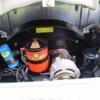To confirm your suspicions, I'd suggest you properly adjust your carbs. Tools needed, (1) airflow meter (Don't waste your money on a Uni-syn, it works, but not as well as a flow meter.
To adjust your carbs, start your engine and let it idle and stabilize. Start with the idle mixture screw located on the outside ottom edge of the carb directly beneath the fuel inlet. This screw has an adjustment spring and is easily damaged if turned "in" too tight. Start on the #1 cylinder and turn the screw in until it lightly stops. The engine will soon start popping and running rough. Slowly, (slowly) turn the screw out until the engine runs crisp. If you over extend the screw, the engine will again falter so start over until correct. Do this to all four cylinders.
Using your flow meter, remove the air cleaners, and stick the meter in each carb. velocity stack. Make sure that each carb is drawing the same amount of air. If not, use the ""idle adjustment screw"" (the screw located on the wide side of the carb next to the butterfly shaft) to run each carb up or down.... Next, run the engine up to 2,500 RPMs and again check. If your linkage is faulty, you'll see a significant difference between carbs.
Another problem could be timing. Run your engine up to around 2,500 RPM's and adjust your timing to a max of 28 degree's advanced. Also, if you have points, the dwell could be off.
On Weber's, there are 2 brass screws parallel and on each side of the fuel bowl inlet. Remove these screws and you'll find the idle jets. They are "'very"" small and easily clog. make sure that the hole is clear and reinstall. Your car is operating off of the idle circut up to 2,500-3,000 RPM's and if they are clogged, it may cause some hesitation and popping.


